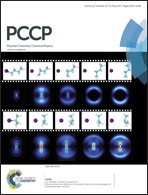An ab initio MO study of heavy atom effects on the zero-field splitting tensors of high-spin nitrenes: how the spin–orbit contributions are affected†
Abstract
The CASSCF and the hybrid CASSCF–MRMP2 methods are applied to the calculations of spin–spin and spin–orbit contributions to the zero-field splitting tensors (D tensors) of the halogen-substituted spin-septet 2,4,6-trinitrenopyridines, focusing on the heavy atom effects on the spin–orbit term of the D tensors (DSO tensors). The calculations reproduced experimentally determined |D| values within an error of 15%. Halogen substitutions at the 3,5-positions are less influential in the spin–spin dipolar (DSS) term of 2,4,6-trinitrenopyridines, although the DSO terms are strongly affected by the introduction of heavier halogens. The absolute sign of the DSO value (D = DZZ − (DXX + DYY)/2) of 3,5-dibromo derivative 3 is predicted to be negative, which contradicts the Pederson–Khanna (PK) DFT result previously reported. The large negative contributions to the DSO value of 3 arise from the excited spin-septet states ascribed mainly to the excitations of in-plane lone pair of bromine atoms → SOMO of π nature. The importance of the excited states involving electron transitions from the lone pair orbital of the halogen atom is also confirmed in the DSO tensors of halogen-substituted para-phenylnitrenes. A new scheme based on the orbital region partitioning is proposed for the analysis of the DSO tensors as calculated by means of the PK-DFT approach.


 Please wait while we load your content...
Please wait while we load your content...